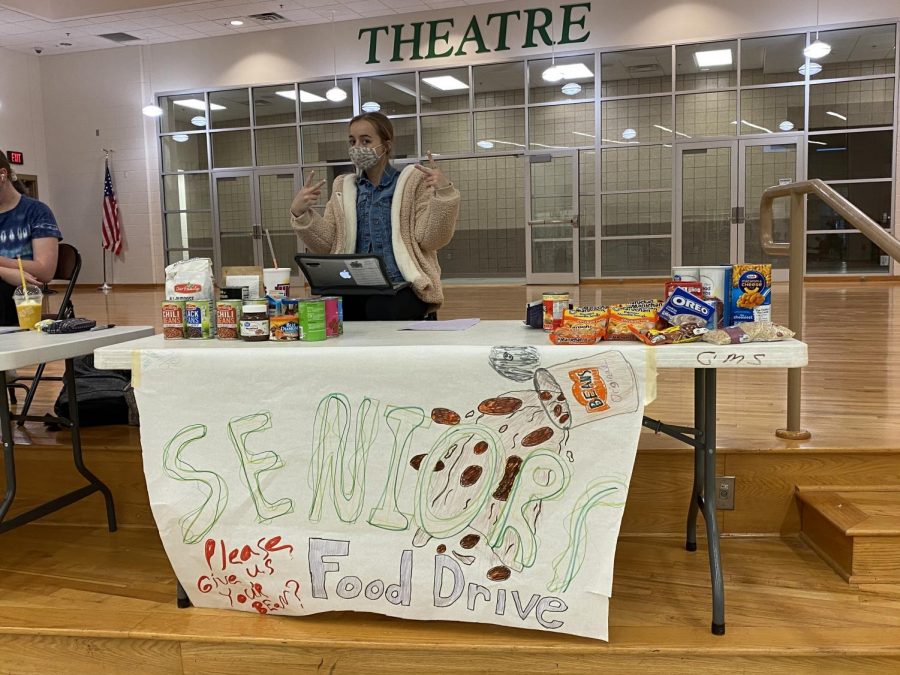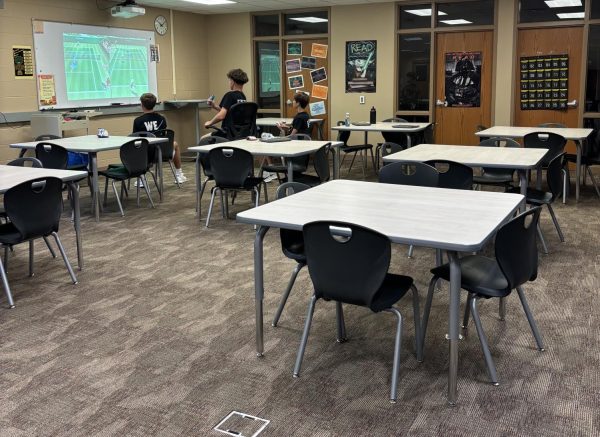High School Food Drive Lacks Drive from Students
Exploration of Donation Shortcomings at GHS Compared to GMS, ACMS
Easy Day: Heading the senior table, Neleah Wozniak (21) completes some school work during a slow food drive day. “I was there to help out with the food drive and count items as they were donated,” Wozniak said. The seniors only had one person donate while Wozniak was working, despite leading the school in total donations.
Given the food shortages in both Gretna and the surrounding area due to COVID-19, the student council decided to move the annual food drive to first semester, instead of holding it second semester like last year. The hope was that the Thanksgiving spirit would encourage more donations in a time when they were needed more than ever. The food drive spanned five days from Nov. 30 to Dec. 5.
“The student council collects non-perishable food items, canned food, and paper products,” student council president senior Sarah Turpen said. “But we will mainly take anything that is not bleach and does not weigh over 5 pounds. The food that we received from our food drive is donated to the Gretna Neighbors food pantry.”
Over the course of the school week, the student council received 98 total items from the student body. The seniors led the way, donating 41 items, followed by 23 from the freshman, 21 from the juniors and 13 from the sophomores. This includes a very underwhelming haul on Wednesday, which totaled one item among all four classes. Although the high school was not generous with the food gifted, the lack of donations is not a problem within the community. According to the Omaha World-Herald, Aspen Creek Elementary collected more than 1,284 pounds of food, as well as raising $1,893 for the Gretna Neighbors food pantry, and Gretna Middle School gathered 5,495 pounds of food during their drive. Neither of these totals factor in paper goods, toiletries or cleaning supplies that also were donated.
“Yes, I did donate more food to the middle school food drives while in middle school,” freshman Rebekah Shaffer said. “They made it more of a big deal.”
Given the current atmosphere of food insecurity across America, it is difficult to attack those who are more reluctant to donate; however, two middle schools in the same district donated hundreds more dollars worth of food than the high school did. The scarcity of food donated is not a community issue, but one specific to GHS.
“I think that the middle school food drive receives more donations for two reasons,” Turpen said. “I think because the middle school does their competition by homeroom and not by the whole class, more people want to participate. The middle school also does a good job of having incentives to donate, such as pie a teacher in the face. My second reason I think the middle school has a better turnout is because parents get involved. I think at the high school age, kids tend to not tell their parents what is happening at school and because of this kids don’t ask their parents if it is okay if they take some food. While the middle schoolers just want to beat the other class.”
The diagnosis given by Turpen seems to be accurate. At the middle schools, a dodgeball tournament and scoring system that is updated daily keeps students engaged. Donations tallied in homeroom also makes students hold each other accountable, as each homeroom wants to win the competition. Most importantly, in middle school, the food drive information is provided to the parents of all the students, and as it turns out, most of the donations from the high schoolers this year came with the aid of parents.
“My mom was the one who got me to donate,” Shaffer said. “She just got some food and asked me if I could take it to school.”
Although upperclassmen are expected to be more independent, even some seniors needed a hand from their guardians to get food to the school for the drive.
“My mom saw that there was a food drive in her emails,” senior Alexis Jansen said. “Every year she looks through our cupboards and pantry for food that we have bought recently but are not going to eat or bought too much of. She bagged it up and sent it with me.”
The low donation efforts in 2020 is not an anomaly; it has been a recurring problem with the food drive for years. On paper, it seems that the problem would be an easy fix. Unfortunately, the student council has taken some measures to try and reverse the trend, but nothing has worked. For example, the student council also announced the food drive and its dates on the high school’s website for the first time. The student council also amended some of the rules regarding the point system with the food drive.
“In the past, student council has asked for specific products on specific days,” Turpen said. “On those days the product that the student brought would double in value. This year we choose to accept anything on any day in hopes that we would receive more items. Some students would buy toilet paper and bring it on a wrong day and would not get the points. Because of this, some students wouldn’t even donate.”
This alteration to the rules, along with other changes. did not seem to have an effect on the results of the food drive. With the given information in front of the student council, and a year for the system to be redesigned, expect a new look to the food drive next fall. At the end of the day, the food drive is not about competition or incentives but helping those in need, which is a trait that is not lacking at GHS.

Matthew McKinney is a senior at GHS and in his first year on The Voice Staff. He serves as a reporter. He is involved in journalism because he feels strongly...







